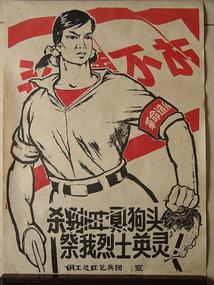
The Wuhan incident (Chinese: 七二零事件; pinyin: Qī èrlíng shìjiàn; lit. 'July 20th Incident') was an armed conflict in the People's Republic of China between two hostile groups who were fighting for control over the city of Wuhan in July 1967, at the height of the Cultural Revolution. The two opposing forces were the "Million Heroes" (Chinese: 百万雄师; pinyin: Bǎi wàn xióngshī) and the "Wuhan Workers' General Headquarters" (Chinese: 工人总部; pinyin: Gōngrén zǒngbù). The former, numbering about 500,000 people, comprised mainly skilled workers, state and local party employees, and were supported by the local PLA, led by the commander of Wuhan Military Region, General Chen Zaidao. The "Wuhan Workers' General Headquarters", also numbering close to 500,000 people, comprised mostly workers and students from Red Guard organizations.[1]
Both sides engaged in an extensive propaganda war in an attempt to enlist community support. Central authorities in Beijing eventually endorsed the Worker's Headquarters faction as the "true" revolutionary group and reprimanded Chen Zaidao for his military support to Million Heroes. The event was considered a pivotal turning point in the Cultural Revolution: it marked the first time military leaders refused to carry out orders given by the central authorities and the Cultural Revolution Group in particular. Fears of a more widespread PLA revolt led Mao and his core associates to scale back the movement's most radical components.
- ^ Meisner, op. 354